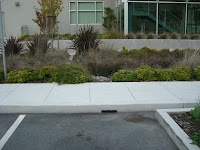Today's stop takes us to Brisbane's City Hall. Finished in early 2009, this project includes both a rain garden and a bioswale. The designer was none other than Kevin Perry from Portland fame. Mr. Perry did the project as a member of Nevue | Ngan, the Portland-based landscape architecture outfit.
Of the two best management practices (BMPs) here, the rain garden is probably the more prominent. Situated on the parking lot-side of City Hall, the rain garden most likely receives more attention from those entering/exiting the building. Also, the interpretive sign sits right by the rain garden. My discussion will thus focus mostly on the rain garden.
The plantings are filling in nicely; the colors and textures blend well, too. What I really like to look at when I check out LID projects is the inlets into the BMP, whether from the street, parking lot, or rooftop. The rain garden has inlets from two locations: the City Hall roof and the adjacent parking lot. In the below images, you can see the downspout, which brings stormwater from the roof and through a decorative trench drain and into the rain garden. Also below, you can see a slot, through which stormwater passes to enter from the parking lot.





The bioswale sits on the streetside of City Hall. The plants here are doing well, too. The bioswale has a "wild" look to it. It receives stormwater from the parking lot via a trench drain. A good amount of debris - leaves, dirt, sediment - has found its way into the trench drain. Maintenance on the trench drains is rather simple - just pick up the covers and remove the gunk. On a previous visit, I actually picked up one of the covers - it was a piece of cake that any slouch can do. Here are a couple of images of the bioswale:




I hope to make it out to El Cerrito's "Green Street" project, San Pablo Avenue. I visited a few weeks ago, and it was a darn shame I didn't have my camera with me. The maples were showing their brilliant fall color, and the planters looked good. Until the next installment!














